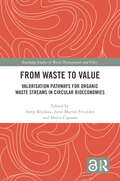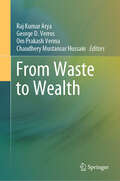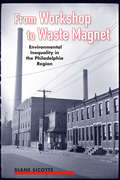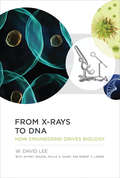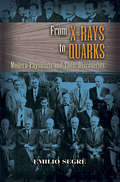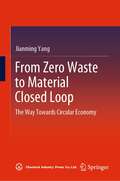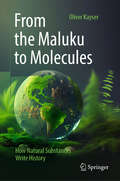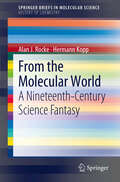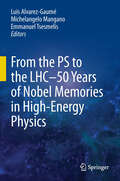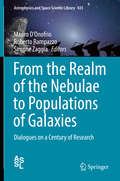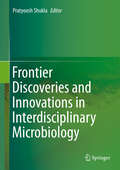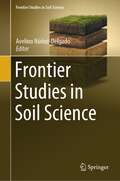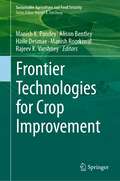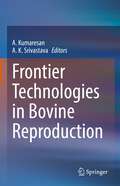- Table View
- List View
From Waste to Value: Valorisation Pathways for Organic Waste Streams in Circular Bioeconomies (Routledge Studies in Waste Management and Policy)
by Antje Klitkou Arne Martin Fevolden Marco CapassoFrom Waste to Value investigates how streams of organic waste and residues can be transformed into valuable products, to foster a transition towards a sustainable and circular bioeconomy. The studies are carried out within a cross-disciplinary framework, drawing on a diverse set of theoretical approaches and defining different valorisation pathways. Organic waste streams from households and industry are becoming a valuable resource in today’s economies. Substances that have long represented a cost to companies and a burden for society are now becoming an asset. Waste products, such as leftover food, forest residues and animal carcasses, can be turned into valuable products such as biomaterials, biochemicals and biopharmaceuticals. Exploiting these waste resources is challenging, however. It requires that companies develop new technologies and that public authorities introduce new regulation and governance models. This book helps policy-makers govern and regulate bio-based industries, and helps industry actors to identify and exploit new opportunities in the circular bioeconomy. Moreover, it provides important insights for all students and scholars concerned with renewable energy, sustainable development and climate change.
From Waste to Wealth
by Chaudhery Mustansar Hussain Om Prakash Verma George D. Verros Raj Kumar AryaThis book serves as a guide, leading readers towards a world where waste ceases to be a burden, but a wellspring of possibilities. Whether the goal is to enhance expertise, ignite creativity, or develop a thorough grasp of waste's transformative possibilities, this book serves to achieve a more sustainable and prosperous future. It provides an invaluable treasure of knowledge for readers, researchers, working professionals, and academics alike, and offers a comprehensive roadmap to address the waste crisis with sustainable solutions. The book introduces readers to a diverse range of sustainable approaches that address the pressing challenges of waste management and resource conservation. From converting waste into building materials to employing waste in innovative 3D printing applications, these sustainable approaches empower individuals to make informed choices for a greener future. It provides in-depth insights that captivate waste management and environmental specialists while offering accessible entry points for those new to the subject.
From Workshop to Waste Magnet: Environmental Inequality in the Philadelphia Region
by Diane SicotteLike many industrialized regions, the Philadelphia metro area contains pockets of environmental degradation: neighborhoods littered with abandoned waste sites, polluting factories, and smoke-belching incinerators. However, other neighborhoods within and around the city are relatively pristine. This eye-opening book reveals that such environmental inequalities did not occur by chance, but were instead the result of specific policy decisions that served to exacerbate endemic classism and racism. From Workshop to Waste Magnet presents Philadelphia's environmental history as a bracing case study in mismanagement and injustice. Sociologist Diane Sicotte digs deep into the city's past as a titan of American manufacturing to trace how only a few communities came to host nearly all of the area's polluting and waste disposal land uses. By examining the complex interactions among economic decline, federal regulations, local politics, and shifting ethnic demographics, she not only dissects what went wrong in Philadelphia but also identifies lessons for environmental justice activism today. Sicotte's research tallies both the environmental and social costs of industrial pollution, exposing the devastation that occurs when mass quantities of society's wastes mix with toxic levels of systemic racism and economic inequality. From Workshop to Waste Magnet is a compelling read for anyone concerned with the health of America's cities and the people who live in them.
From X-rays to DNA: How Engineering Drives Biology
by W. David Lee Jeffrey Drazen Phillip A. Sharp Robert S. LangerEngineering has been an essential collaborator in biological research and breakthroughs in biology are often enabled by technological advances. Decoding the double helix structure of DNA, for example, only became possible after significant advances in such technologies as X-ray diffraction and gel electrophoresis. Diagnosis and treatment of tuberculosis improved as new technologies -- including the stethoscope, the microscope, and the X-ray -- developed. These engineering breakthroughs take place away from the biology lab, and many years may elapse before the technology becomes available to biologists. In this book, David Lee argues for concurrent engineering -- the convergence of engineering and biological research -- as a means to accelerate the pace of biological discovery and its application to diagnosis and treatment. He presents extensive case studies and introduces a metric to measure the time between technological development and biological discovery. Investigating a series of major biological discoveries that range from pasteurization to electron microscopy, Lee finds that it took an average of forty years for the necessary technology to become available for laboratory use. Lee calls for new approaches to research and funding to encourage a tighter, more collaborative coupling of engineering and biology. Only then, he argues, will we see the rapid advances in the life sciences that are critically needed for life-saving diagnosis and treatment.
From X-rays to DNA: How Engineering Drives Biology (The\mit Press Ser.)
by W. David LeeAn argument that technology accelerates biological discovery, with case studies ranging from chromosome discovery with early microscopes to how DNA replicates using radioisotope labels.Engineering has been an essential collaborator in biological research and breakthroughs in biology are often enabled by technological advances. Decoding the double helix structure of DNA, for example, only became possible after significant advances in such technologies as X-ray diffraction and gel electrophoresis. Diagnosis and treatment of tuberculosis improved as new technologies—including the stethoscope, the microscope, and the X-ray—developed. These engineering breakthroughs take place away from the biology lab, and many years may elapse before the technology becomes available to biologists. In this book, David Lee argues for concurrent engineering—the convergence of engineering and biological research—as a means to accelerate the pace of biological discovery and its application to diagnosis and treatment. He presents extensive case studies and introduces a metric to measure the time between technological development and biological discovery.Investigating a series of major biological discoveries that range from pasteurization to electron microscopy, Lee finds that it took an average of forty years for the necessary technology to become available for laboratory use. Lee calls for new approaches to research and funding to encourage a tighter, more collaborative coupling of engineering and biology. Only then, he argues, will we see the rapid advances in the life sciences that are critically needed for life-saving diagnosis and treatment.
From X-rays to Quarks: Modern Physicists and Their Discoveries
by Emilio SegrèA leading figure in twentieth-century physics offers impressions and recollections of the field's development. Nobel Laureate Emilio Segrè (1905-89) knew and worked with many of modern physics' preeminent scientists. In this simple but elegant history, he offers compelling views not only of the milestones of scientific discovery but also the personalities involved--their attitudes and politics as well as their trials and triumphs. Highlights include a profile of Albert Einstein, from his unconventional youth to his role as science's elder statesman; the wonder year of 1932, which witnessed the discoveries of the neutron, positron, and deuterium; and the first steps in building particle accelerators.A student and colleague of Enrico Fermi, Segrè made numerous important contributions to nuclear physics, including participation in the Manhattan Project. Segrè is further renowned for his narrative skills as a historian. This book is a companion to the author's From Falling Bodies to Radio Waves: Classical Physicists and Their Discoveries, also available from Dover Publications.
From Zero Waste to Material Closed Loop: The Way Towards Circular Economy
by Jianming YangThis book interprets the economic benefits and social benefits brought about by zero waste. Beginning with the general history of waste, its mechanism and different categories, this book first explores waste management and resourcing technology around the world nowadays. It then elaborates on the concept and practices of zero waste, discussing about the relationship between zero waste and eco-design, and about relative international standards. At last, it points out that zero waste could be the pathway from linear economy to circular economy, backed up by theories and practices.This book offers a clear direction for companies and organizations about environment. It can also be used as a sustainable development strategy handbook for executives in companies and organizations.
From a Photograph: Authenticity, Science and the Periodical Press, 1870-1890
by Geoffrey BelknapThroughout its early history, photography's authenticity was contested and challenged: how true a representation of reality can a photograph provide? Does the reproduction of a photograph affect its value as authentic or not? From a Photograph examines these questions in the light of the early scientific periodical press, exploring how the perceived veracity of a photograph, its use as scientific evidence and the technologies developed for printing it were intimately connected.Before photomechanical printing processes became widely used in the 1890s, scientific periodicals were unable to reproduce photographs and instead included these photographic images as engravings, with the label ‘from a photograph’. Consequently, every image was mediated by a human interlocutor, introducing the potential for error and misinterpretation. Rather than ‘reading’ photographs in the context of where or how they were taken, this book emphasises the importance of understanding how photographs are reproduced. It explores and compares the value of photography as authentic proof in both popular and scientific publications during this period of significant technological developments and a growing readership. Three case studies investigate different uses of photography in print: using pigeons to transport microphotographs during the Franco-Prussian War; the debate surrounding the development of instantaneous photography; and finally the photographs taken of the Transit of Venus in 1874, unseen by the human eye but captured on camera and made accessible to the public through the periodical.Addressing a largely overlooked area of photographic history, From a Photograph makes an important contribution to this interdisciplinary research and will be of interest to historians of photography, print culture and science.
From an Idea to Google: How Innovation at Google Changed the World (From an Idea to)
by Lowey Bundy SicholFrom an Idea to Google is a behind-the-computer-screen look into the history, business, and brand of the world's largest search engine. With humorous black & white illustrations throughout, learn about the company that even earned its own catchphrase: Google it!Today, Google is the number one internet search engine and the most visited website in the world. But a long time ago, two college friends, Larry Page and Sergey Brin, started out with just an idea. Find out more about Google’s history, the business, and the brand in this illustrated nonfiction book! Find out where the name “Google” came from. (Hint: It involves a LOT of zeros!) Discover how Google became the fastest and most popular internet search engine of all time. Explore how Google transformed from a tiny startup (in someone’s garage!) into one of the most powerful companies in the world.
From an Idea to Lego: The Building Bricks Behind the World's Largest Toy Company (From An Idea To Ser.)
by Lowey Bundy SicholFor fans of the successful Who Was series, From an Idea to Lego is a behind-the-bricks look into the world's famous toy company, with humorous black & white illustrations throughout.Today, LEGO is one of the biggest toy companies in the world, but a long time ago, a Danish carpenter, Ole Kirk Christiansen, started with just an idea. Find out more about LEGO&’s origins, those famous bricks, and their other inventive toys and movie ventures in this illustrated nonfiction book!Find out the origin the name &“LEGO.&” (Hint: it combines two Danish words)See how LEGO grew from a carpentry shop to a multi-platform toy company.Discover how LEGO bricks are made and how they came up with their design.
From scientific instrument to industrial machine
by Sjir Van Loo Richard DoornbosArchitectural stress is the inability of a system design to respond to new market demands. It is an important yet often concealed issue in high tech systems. In From scientific instrument to industrial machine, we look at the phenomenon of architectural stress in embedded systems in the context of a transmission electron microscope system built by FEI Company. Traditionally, transmission electron microscopes are manually operated scientific instruments, but they also have enormous potential for use in industrial applications. However, this new market has quite different characteristics. There are strong demands for cost-effective analysis, accurate and precise measurements, and ease-of-use. These demands can be translated into new system qualities, e.g. reliability, predictability and high throughput, as well as new functions, e.g. automation of electron microscopic analyses, automated focusing and positioning functions. From scientific instrument to industrial machine takes a pragmatic approach to the problem of architectural stress. In particular, it describes the outcomes of the Condor project, a joint endeavour by a consortium of industrial and academic partners. In this collaboration an integrated approach was essential to successfully combine various scientific results and show the first steps towards a new direction. System modelling and prototyping were the key techniques to develop better understanding and innovative solutions to the problems associated with architectural stress. From scientific instruments to industrial machine is targeted mainly at industrial practitioners, in particular system architects and engineers working on high tech systems. It can therefore be read without particular knowledge of electron microscope systems or microscopic applications. The book forms a bridge between academic and applied science, and high tech industrial practice. By showing the approaches and solutions developed for the electron microscope, it is hoped that system designers will gain some insights in how to deal with architectural stress in similar challenges in the high tech industry.
From the Earth to the Moon and Around the Moon (The Jules Verne Collection)
by Jules VerneGun experts set their sights on shooting a man to the moon in these two novels by Jules Verne—now available together with an arresting new look!In the aftermath of the American Civil War, the members of The Baltimore Gun Club find themselves in a dilemma—without a war, there is no demand for their innovative gun designs. Eager for a new challenge, the club&’s President Barbicane sets an ambitious goal: to build the largest gun in the world, powerful enough to shoot a man to the moon. Such a gun has never been attempted, so the club faces a myriad of challenges including what to make it from, where to build it, when to shoot it, and—most importantly—how to ensure that a passenger inside the gun&’s projectile can survive the trip. In From Earth to the Moon, the members of the gun club undertake the engineering challenge, and Around the Moon follows the three voyagers on their journey to the moon and back.
From the Horse's Point of View
by Andrea KutschAn eye-opening book leading equestrians into a brave new horse world, where we train horses their way, not ours.For years, Andrea Kutsch filled stadiums with spectators as she demonstrated remarkable transformations in &“problem horses&” using the Natural Horsemanship training methods she'd learned from leaders in the field. But something was bothering her
From the Maluku to Molecules: How Natural Substances Write History
by Oliver KayserNatural products are a marvel of evolution. Plants are chemical factories and have produced a vast number of highly diverse and interesting natural substances with their extraordinary properties, which we humans have been using for centuries to relieve and cure diseases. At the latest since the discovery of penicillin, natural substances have become an important source of medicines, but we know only very few of the presumably many millions that are still waiting to be discovered. Important antibiotics, immunosuppressants, anticancer agents, hormones, and antiviral agents are among the natural products. But do natural products still matter in the age of biotechnology and genetic engineering? Yes, more than ever, because medicinal chemists draw creative inspiration for their syntheses from nature to develop the next blockbuster in medicine. Oliver Kayser tells the story of natural products and medicinal plants in this book in a highly informative and amusing way from a new perspective. He explores how natural products from naturopathy gave birth to the pharmaceutical industry, how they shaped our society as medicines and remedies, enabled wars, and paved the way to Nobel Prizes. The author paints a fascinating panorama of natural product chemistry in plants, microorganisms, and animals. Starting with the first isolations at the beginning of the industrial revolution, he leads us with the ideas and enthusiasm of many scientists into the modern era of drug testing, computer chemistry, and the highly successful serendipitous discoveries of active ingredients. Natural product research in the laboratory has an enormous impact on our lives today. The author offers a glimpse over the shoulder of how the search for the new drugs of tomorrow works today. This book is the ultimate book from the pen of a scientist deeply rooted in research, providing the reader with an enlightening and at the same time entertaining insight into how scientists think and how arduous research can be.
From the Molecular World
by Alan J. Rocke Hermann KoppHermann Kopp (1817-1892) is best remembered today as a historian of chemistry, but during his lifetime he was one of the most eminent chemists of his day, and one of the earliest pioneers of physical chemistry. Late in his career he wrote an endearing fantasy about personified molecules. Published in 1882, Aus der Molecular-Welt (From the Molecular World) portrayed the intimate details of what might actually be happening in the sub-microscopic world; the atoms and molecules we meet there have agency, personalities, sometimes even dialog. Filled with appealing tropes, humor, and whimsical asides, Kopp's short book provided an examination of the chemistry and physics of his day that was always light-hearted on the surface, but often surprisingly profound. Properly interpreted, the book provides a revealing tour of nineteenth-century debates concerning chemical theory. It is here translated into English, richly annotated, and equipped with an illuminating preface by a leading historian of chemistry. It provides entertaining reading to practicing chemists, as well as new insights to historians of science.
From the PS to the LHC - 50 Years of Nobel Memories in High-Energy Physics
by Luis Alvarez-Gaumé Emmanuel Tsesmelis Michelangelo ManganoThis collection of lectures and essays by eminent researchers in the field, many of them nobel laureates, is an outgrow of a special event held at CERN in late 2009, coinciding with the start of LHC operations. Careful transcriptions of the lectures have been worked out, subsequently validated and edited by the lecturers themselves. This unique insight into the history of the field includes also some perspectives on modern developments and will benefit everyone working in the field, as well as historians of science.
From the Realm of the Nebulae to Populations of Galaxies
by Mauro D'Onofrio Roberto Rampazzo Simone ZaggiaIn order to outline possible future directions in galaxy research, this book wants to be a short stopover, a moment of self-reflection of the past century of achievements in this area. Since the pioneering years of galaxy research in the early 20th century, the research on galaxies has seen a relentless advance directly connected to the parallel exponential growth of new technologies. Through a series of interviews with distinguished astronomers the editors provide a snapshot of the achievements obtained in understanding galaxies. While many initial questions about their nature have been addressed, many are still open and require new efforts to achieve a solution. The discussions may reveal paradigms worthwhile revisiting. With the help of some of those scientists who have contributed to it, the editors sketch the history of this scientific journey and ask them for inspirations for future directions of galaxy research.
From the Universe to the Elementary Particles
by Ulrich EllwangerIn this book, the author leads the reader, step by step and without any advanced mathematics, to a clear understanding of the foundations of modern elementary particle physics and cosmology. He also addresses current and controversial questions on topics such as string theory. The book contains gentle introductions to the theories of special and general relativity, and also classical and quantum field theory. The essential aspects of these concepts are understood with the help of simple calculations; for example, the force of gravity as a consequence of the curvature of the space-time. Also treated are the Big Bang, dark matter and dark energy, as well as the presently known interactions of elementary particles: electrodynamics, the strong and the weak interactions including the Higgs boson. Finally, the book sketches as yet speculative theories: Grand Unification theories, supersymmetry, string theory and the idea of additional dimensions of space-time. Since no higher mathematical or physics expertise is required, the book is also suitable for college and university students at the beginning of their studies. Hobby astronomers and other science enthusiasts seeking a deeper insight than can be found in popular treatments will also appreciate this unique book.
From the Watching of Shadows: The Origins of Radiological Tomography
by S. WebbFrom the Watching of Shadows: The Origins of Radiological Tomography presents the first complete history of body imaging by discrete sections, from its earliest beginnings around 1920 to modern times. Divided into two parts, the book is highly illustrated with many original figures from patents and some previously unpublished pictures. The first part covers classical tomography from 1920 to the 1960s, including the origins of radiological tomography. The second part takes a fresh look at computed transmission and emission tomography that includes recent developments by pioneering tomographers. Tables in each chapter summarize key historical landmarks. The book also includes an extensive glossary of technical terms and a comprehensive index. It is ideal reading for diagnostic radiologists and radiographers interested in the origins of their techniques, for practicing medical physicists, and for historians of medicine and science.
From the Web to the Grid and Beyond
by René Brun Giuliana Galli Carminati Federico CarminatiBorn after World War II, large-scale experimental high-energy physics (HEP) has found itself limited ever since by available accelerator, detector and computing technologies. Accordingly, HEP has made significant contributions to the development of these fields, more often than not driving their innovations. The invention of the World Wide Web at CERN is merely the best-known example out of many. This book is the first comprehensive account to trace the history of this pioneering spirit in the field of computing technologies. It covers everything up to and including the present-day handling of the huge demands imposed upon grid and distributed computing by full-scale LHC operations--operations which have for years involved many thousands of collaborating members worldwide and accordingly provide the original and natural testbed for grid computing concepts. This book takes the reader on a guided tour encompassing all relevant topics, including programming languages, software engineering, large databases, the Web, and grid- and cloud computing. The important issue of intellectual property regulations for distributed software engineering and computing is also addressed. Aptly, the book closes with a visionary chapter of what may lie ahead. Approachable and requiring only basic understanding of physics and computer sciences, this book is intended for both education and research.
Frontier Discoveries and Innovations in Interdisciplinary Microbiology
by Pratyoosh ShuklaThis excellent book covers wide-ranging topics in interdisciplinary microbiology, addressing various research aspects and highlighting advanced discoveries and innovations. It presents the fascinating topic of modern biotechnology, including agricultural microbiology, microalgae biotechnology, bio-energy, bioinformatics and metagenomics, environmental microbiology, enzyme technology and marine biology. It presents the most up-to-date areas of microbiology with an emphasis on shedding light on biotechnological advancements and integrating these interdisciplinary microbiology research topics into other biotechnology sub-disciplines. The book raises awareness of the industrial relevance of microbiology, which is key component of this unique collection. The topics include production of antioxidant-glutathione, enzyme-engineering methods, probiotic microbiology and features of microbial xylanases. It also covers some other remarkable aspects of microbiology, like potential health hazards in recreational water and fullerene nanocomposites, which are vital for biotechnological interventions. This book will be valuable resource for senior undergraduate and graduate students, researchers and other interested professionals or groups working in the interdisciplinary areas of microbiology and biotechnology.
Frontier Science: Northern Canada, Military Research, and the Cold War, 1945–1970
by Matthew WisemanBetween 1945 and 1970, Canada’s Department of National Defence sponsored scientific research into the myriad challenges of military operations in cold regions. To understand and overcome the impediments of the country’s cold climate, scientists studied cold-weather acclimatization, hypothermia, frostbite, and psychological morale for soldiers assigned to active duty in northern Canada. Frontier Science investigates the history of military science in northern Canada during this period of the Cold War, highlighting the consequences of government-funded research for humans and nature alike. The book reveals how under the guise of “environmental protection” research, the Canadian military sprayed pesticides to clear bushed areas, used radioactive substances to investigate vector-borne diseases, pursued race-based theories of cold tolerance, and enabled wide-ranging tests of newly developed weapons and equipment. In arguing that military research in northern Canada was a product of the Cold War, Matthew S. Wiseman tackles questions of government power, scientific authority, and medical and environmental research ethics. Based on a long and deep pursuit of declassified records, archival sources, and oral testimony, Frontier Science is a fascinating new history of military approaches to the human-nature relationship.
Frontier Studies in Soil Science (Frontier Studies in Soil Science)
by Avelino Núñez-DelgadoThis is the first book where top researchers focus on presenting new research proposals in soil science. All the authors contributing to the book have a solid background and experience in specific fields of soil science, allowing them to propose the critical lines of future development in their respective and particular paths of cut-edge investigation. The primary audiences for the work are scientists/researchers working in these fields, as well as students interested in the views from top scientists on recent and future trends in the area, and all those in the overall society desiring to be aware of possible pathways for the future of soil science.
Frontier Technologies for Crop Improvement (Sustainability Sciences in Asia and Africa)
by Rajeev K. Varshney Manish Roorkiwal Manish K. Pandey Alison Bentley Haile DesmaeThis edited book is a compilation of information on existing frontier technologies in agriculture, such as driving modernized crop improvement programs via digitalization, mechanization and automation, artificial intelligence, speed breeding. The major focus of the book is on the technologies related to genetic gain, nutrition and food safety. Agriculture is core to industry as well as human civilization and sustainability of the society. Therefore, advancement and investment of technology is essential for enhancing the quality and quantity of the produce for ensuring food and nutritional security. The frontier technologies bring drastic change in the way of functioning leading to multi-fold increase in efficiency and outcome. Chapters in this book addresses a particular enabling technology and forward-looking strategy. Compiled information with successful deployment examples of these technologies is not been made available from a single platform, therefore, this volume is a unified compilation of information from international experts. The book is a relevant reading material for students, researchers, academicians and industry players in agriculture.
Frontier Technologies in Bovine Reproduction
by A. Kumaresan A. K. SrivastavaThis book details the frontier technologies in the area of bovine reproduction. It describes the importance and significance of different technologies for improving reproduction efficiency in bovines. The book delineates the advancements in the technologies that are currently in use for faster multiplication of elite germ plasm including multiple ovulation and embryo transfer, ovum-pick-up, in vitro fertilization and embryo production, and semen sexing. Other emerging technologies, having potential for improving reproductive efficiency in bovines, including stem cells are also discussed with special reference to spermatogonial stem cells. Simple but effective tools having a great scope for day-to-day application in bovine farms for effective reproductive management like ultrasonography and thermal imaging are also covered in this book. The chapters on sperm transcriptomics, proteomics, metabolomics provide current developments in these areas and use of integrated approach for identification of fertility biomarkers. The chapters also describe technological advancements for early pregnancy diagnosis and offspring sex pre-selection in bovines. Additionally, this book discusses different sperm selection procedures including application of nanotechnology to obtain superior spermatozoa for assisted reproduction. Futuristic technologies including genomic selection and transgenesis are also discussed in detail. Finally, the book also elucidates a comprehensive description of challenges perceived with bovine reproduction and how effectively these technologies can help in improving fertility in bovines.
